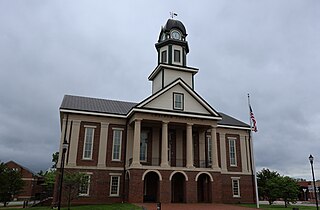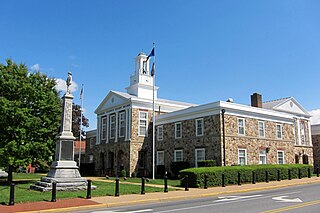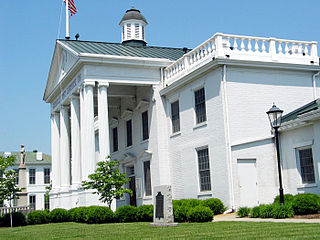
Roanoke College is a private liberal arts college in Salem, Virginia. It has approximately 2,000 students who represent approximately 40 states and 30 countries. The college offers 35 majors, 57 minors and concentrations, and pre-professional programs. Roanoke awards bachelor's degrees in arts, science, and business administration and is one of 280 colleges with a chapter of the Phi Beta Kappa honor society.

Rocky Mount is a town in and the county seat of Franklin County, Virginia, United States. The town is part of the Roanoke Metropolitan Statistical Area, and had a population of 4,903 as of the 2020 census. It is located in the Roanoke Region of Virginia.

Monument Avenue is a tree-lined grassy mall dividing the eastbound and westbound traffic in Richmond, Virginia, originally named for its emblematic complex of structures honoring those who fought for the Confederacy during the American Civil War. Between 1900 and 1925, Monument Avenue greatly expanded with architecturally significant houses, churches, and apartment buildings. Four of the bronze statues representing J. E. B. Stuart, Stonewall Jackson, Jefferson Davis and Matthew Fontaine Maury were removed from their memorial pedestals amidst civil unrest in July 2020. The Robert E. Lee monument was handled differently as it was owned by the Commonwealth, in contrast with the other monuments which were owned by the city. Dedicated in 1890, it was removed on September 8, 2021. All these monuments, including their pedestals, have now been removed completely from the Avenue. The last remaining statue on Monument Avenue is the Arthur Ashe Monument, memorializing the African-American tennis champion, dedicated in 1996.

The current Franklin County Courthouse in Chambersburg, Pennsylvania, built in 1865, is the third courthouse building on the site. The site was originally purchased from Colonel Benjamin Chambers in 1785.

The Jefferson County Courthouse is a historic building in Charles Town, West Virginia, USA. The building is historically notable as the site of two trials for treason: that of John Brown in 1859, and those of unionizing coal miners from Mingo County, West Virginia, a consequence of the Battle of Blair Mountain, whose trials were moved from the southern part of the state in 1922 as a result of a change of venue. It was designated a National Historic Landmark in 2023 for its role in the mining wars.

The Confederate Monument in Murray is a statue located in the northeast corner of the Calloway County Courthouse in Murray, Kentucky. It commemorates the 800 citizens of the county who served in the Confederate Army during the American Civil War, and is one of several Confederate monuments in Kentucky featuring Robert E. Lee. There is another one in Bardstown KY. Despite recent controversy, the Calloway County Fiscal Court voted to keep the statue on its grounds in July 2020.

The Lancaster Court House Historic District is a national historic district consisting of 25 structures, including one monument, located in Lancaster, Virginia, Lancaster County, Virginia. Four of the buildings make up the Mary Ball Washington Museum and Library, founded in 1958, whose purpose is to preserve and interpret the history of Lancaster County, Virginia.

The Chatham County Courthouse is a historic courthouse located at Pittsboro, Chatham County, North Carolina. It sits at the center of town in the middle of a traffic circle. It was built in 1881 for $10,666 and is a two-story rectangular brick structure in the Late Victorian style. It features a two-story classical portico crowned with a distinctive three-stage cupola. A one-story addition was built in the 1930s by the Works Progress Administration. In 1959, extensive renovations were performed on the building.

The Cumberland County Courthouse is a historic courthouse building located at Cumberland, Cumberland County, Virginia. It was built by Dabney Cosby, a master builder for Thomas Jefferson, in 1818. It is a brick, one-story, rectangular, gable-roofed courthouse. The building features the Tuscan order throughout and a tetrastyle portico. Also included are the contributing small, brick, one-story clerks office; the brick, two-story, gable-roofed former jail; and Confederate Civil War monument (1901).

Brunswick County Courthouse Square is a historic county courthouse complex and national historic district located at Lawrenceville, Brunswick County, Virginia. It encompasses four contributing buildings and two contributing objects. They are the courthouse building, a clerk's office, library, jail, Confederate war monument, and a simple granite slab monument commemorating the county's veterans of World War I to the Vietnam War. Together they constitute a classic Southern courthouse square. The courthouse was built in 1854–55, as a two-story, gable-roofed rectangular brick building in the Greek Revival style. In 1939, a rear brick addition was completed, creating a T-shaped plan. The clerk's office is a two-story brick building built in 1893, with rear additions built in 1924 and 1939. The library was built in 1941.

Buckingham Courthouse Historic District is a historic county courthouse complex and national historic district located at Buckingham, Buckingham County, Virginia. It encompasses 10 contributing buildings and 1 contributing object. The courthouse building was built in 1873, and is a two-story temple-form Greek Revival style building fronted by a pedimented tetrastyle Doric order portico. It replaced an earlier courthouse designed by Thomas Jefferson and built between 1822 and 1824, but burned down in 1869. Also included in the district is the former Buckingham Tavern, former Buckingham Inn, the Leach House, the Presbyterian manse, the Masonic Hall, a brick house called West View, the Trinity Presbyterian Church, and Confederate monument.

Caroline County Courthouse is a historic county courthouse located at Bowling Green, Caroline County, Virginia. It was built about 1830, and is a two-story, four bay wide, brick temple form building in the Jeffersonian Roman Revival style. The building is surrounded by a Tuscan entablature with a Tuscan pediment at either end. The front facade features an open arcade one-bay deep on the ground floor with six rounded arches.

The Charles City County Courthouse is a historic county courthouse located at Charles City, Charles City County, Virginia. It was built about 1730, and is a one-story, T-shaped, brick structure. It has an apparently original modillion cornice and a steep hipped roof covered in tin. It features an arcaded front. Also on the property are a contributing Confederate monument, a late 19th-century clerk's office with later additions, and a frame jail building built about 1867.

Frederick County Courthouse is a historic county courthouse located at Winchester, Frederick County, Virginia. It was built in 1840, and is a two-story, rectangular, brick building on a stone foundation and partial basement in the Greek Revival style. It measures 50 feet by 90 feet, and features a pedimented Doric order portico and a gabled roof surmounted by a cupola. Also on the property is a contributing Confederate monument, dedicated in 1916, consisting of a bronze statue of a soldier on a stone base.
Pleasant Grove, also known as Joseph Deyerle House, Deyerle Homeplace, and Glenvar is a historic home located near Salem in Roanoke County, Virginia. It was built in 1853, and is a two-story, three-bay, Greek Revival style brick dwelling. The front facade features a well-proportioned Ionic order portico with slender tapered, fluted columns. It also has an original sunroom measuring 7 feet by 14 feet. Also on the property are the contributing kitchen, spring house, smokehouse, servant's house, and privy.

Warren County Courthouse is a historic county courthouse complex located at Front Royal, Warren County, Virginia. It was built in 1935–1936, and is a two-story, stone faced concrete block, Colonial Revival style building. It consists of a central rectangular block with a pedimented gable roof and smaller flanking recessed wings. The central block is topped by a three-stage cupola with an open and domed belfry. Also on the property are the contributing brick clerk's office, brick jail, and two war memorials - a Confederate Monument, dedicated in 1911, and an obelisk honoring veterans of World Wars I and II.

Greensville County Courthouse Complex is a historic courthouse complex located at South Main Street between Hicksford Avenue and Spring Street in Emporia, Virginia. The three contributing buildings are the two-story, porticoed courthouse built in 1834, the clerk's office built in 1894, and the former Greensville Bank Building, now the county administrator's office, in 1900 and 1907. The courthouse originally took a Palladian form, but was remodeled between 1907 and 1910 to take a Beaux-Arts appearance. The clerk's office was considerably enlarged in 1916 and the Georgian-style facade added in 1961. The interior of the county administrator's office features elaborate pressed-tin walls and ceilings manufactured by the local concern, H.J. Klugel. The buildings are set upon the courthouse square, which includes a cannon honoring residents who participated in World War I, and a Confederate monument.

Warwick County Courthouses, also known as the Warwick County Courthouse and Clerk's Office, is a historic courthouse and clerk's office located at Newport News, Virginia. The original courthouse was built in 1810, and is a one-story, three-room, T-shaped plan Federal-style brick building. It has a slate-covered gable roof and exterior end chimneys. The building was later enlarged by a side and rear addition. The later courthouse was built in 1884, and is a two-story, Italianate style brick building. It has a rectangular plan and a shallow metal-covered hipped roof with three shallow cross gables. It features a square wood bell cupola that rises above the central projecting bay. Also on the property is a contributing Confederate monument dedicated in 1909. The buildings housed county offices until 1958, when Warwick County, Virginia was annexed by Newport News.

Downtown Salem Historic District is a national historic district located at Salem, Virginia. The district encompasses 34 contributing buildings and 1 contributing site in downtown Salem. The district includes primarily mixed-use commercial buildings, but also includes churches, dwellings, a courthouse, a post office, a library, a park, and the covered stalls of a farmer's market. The buildings mostly date from the late-19th and early-20th century and are in a variety of popular architectural styles including Greek Revival, Italianate, and Queen Anne. Notable buildings include the Stevens House or "Old Post House" (1820s-1830s), Kizer-Webber Building (1883-1886), Duval-Oakey House (1891-1898), Salem High School, Old Salem Municipal Building and Fire Department (1925), Quality Bakery Building, Olde Newberry Building (1929), Salem Theater, and James J. True Building (1927). Located in the district are the separately listed Old Roanoke County Courthouse, Salem Presbyterian Church, and Salem Post Office.

Forsyth County Courthouse is a historic county courthouse located at Winston-Salem, Forsyth County, North Carolina. It was built in 1926, and is a three-story, limestone clad, Beaux-Arts style building that incorporates interior elements of the earlier 1896, Romanesque Revival style courthouse. Between 1959 and 1960, additions were built onto the front and rear. It has been converted into private apartments and in 2018, was owned by Winston Courthouse LLC. In front of it for decades was the Confederate Soldiers Monument, which was removed in 2019.























